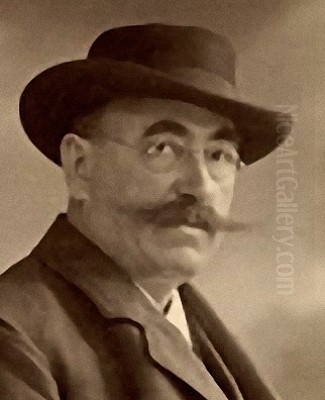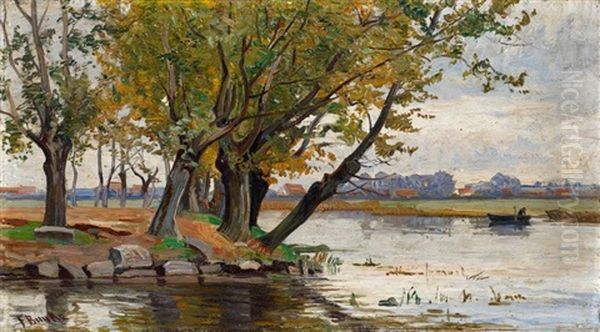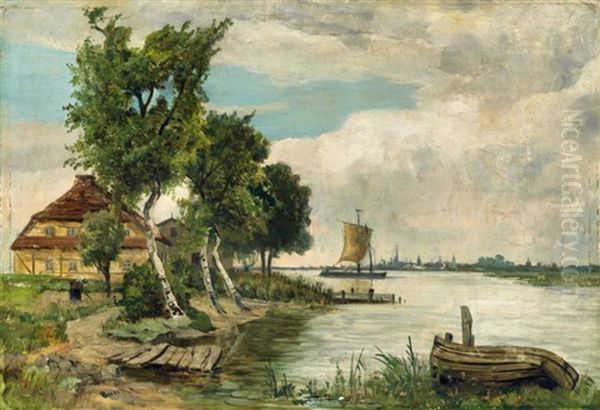
Franz Bunke (1857-1939) stands as a significant figure in German art history, particularly celebrated for his evocative landscape paintings and his foundational role in establishing the Schwaan artists' colony, the only one of its kind in the Mecklenburg region. His dedication to outdoor painting, or plein-air techniques, marked him as a pioneer in capturing the unique light and atmosphere of his homeland. This article delves into the life, work, influences, and legacy of this distinguished German artist.
Early Life and Artistic Awakening in Mecklenburg
Born on December 3, 1857, in Schwaan, a small town in the Grand Duchy of Mecklenburg-Schwerin, Franz Bunke's early life was steeped in the pastoral beauty of the region. The Warnow River, the expansive meadows, and the distinctive northern German skies would become recurring motifs in his later work. His artistic inclinations were recognized early, leading him to seek formal training.
His initial artistic instruction came from Paul Tischbein in Rostock, a nearby city. Tischbein, part of a notable German family of painters, likely provided Bunke with a solid grounding in traditional drawing and painting techniques. This early exposure in Rostock would have been crucial in honing his observational skills and fostering his passion for depicting the world around him. The experience under Tischbein set the stage for Bunke's more advanced academic pursuits.
Academic Pursuits: Berlin and the Weimar School
In 1878, seeking to further his artistic education, Franz Bunke enrolled at the prestigious Royal Prussian Academy of Arts in Berlin (Königlich Preußische Akademie der Künste). The Berlin Academy was a center of academic art in Germany, emphasizing classical ideals and rigorous technical training. Here, Bunke would have been exposed to a wider range of artistic theories and practices, and would have interacted with a diverse student body and faculty.

However, it was his subsequent move to the Grand Ducal Saxon School of Art in Weimar (Großherzoglich-Sächsische Kunstschule Weimar) that proved most formative. He began his studies there in 1882, and from 1884, he came under the tutelage of Professor Theodor Hagen (1842-1919). Hagen was a prominent landscape painter and a key proponent of plein-air painting in Germany, heavily influenced by the French Barbizon School and early Impressionism. Under Hagen's guidance, Bunke fully embraced the practice of painting outdoors, directly observing and capturing the transient effects of light and color in nature. This period was instrumental in shaping his artistic identity and his commitment to landscape painting.
The Weimar School of Art itself was a significant institution, known for fostering a more progressive approach to art compared to some other German academies. It attracted artists who were keen to explore new modes of expression, particularly in landscape painting. Bunke's time in Weimar was not just about learning; it was about becoming part of a movement that sought a more direct and truthful engagement with the natural world.
The Weimar School and Its Circle
During his time at the Weimar School of Art, Franz Bunke was part of a vibrant artistic community. The school, under figures like Theodor Hagen, became a crucible for the development of German Impressionism and plein-air painting. Bunke interacted with and was influenced by a number of contemporaries who also made significant contributions to German art.
Among these were artists like Christian Rohlfs (1849-1938), who, though later known for his Expressionist works, was associated with the Weimar School and its emphasis on naturalism in his earlier career. Paul Baum (1859-1932) was another important figure, a contemporary of Bunke who also studied at Weimar and became a leading German Neo-Impressionist. Karl Buchholz (1849-1889), known for his melancholic and atmospheric landscapes, was also part of this milieu, having been a student of Hagen.
Ludwig von Hofmann (1861-1945), though perhaps more aligned with Art Nouveau and Symbolism, also had connections to Weimar and represented the diverse artistic currents present. Other artists associated with the Weimar School's ethos during this period included Paul Tübbecke, Emil Zschokke, Erika Zschokke, Max Carmer, and Eduard Weibrich. This environment of shared exploration and dedication to landscape painting provided a fertile ground for Bunke's development. The emphasis was on moving away from the heroic or overly romanticized landscapes of earlier generations towards a more intimate and direct portrayal of nature.

The influence of French Impressionists like Claude Monet, Camille Pissarro, and Alfred Sisley was beginning to permeate German art circles, and Weimar was one of the places where these new ideas were actively discussed and adapted. Theodor Hagen, Bunke's mentor, played a crucial role in transmitting these influences, encouraging his students to lighten their palettes and focus on capturing the sensory experience of being in the landscape.
The Genesis of the Schwaan Artists' Colony
Franz Bunke's deepest connection remained with his native Mecklenburg. Inspired by his experiences in Weimar and the growing trend of artists forming colonies in picturesque rural locations (like Worpswede in Northern Germany or Barbizon in France), Bunke envisioned a similar artistic hub in Schwaan. Starting around 1892, Bunke, by then a professor at the Weimar School, began to bring his students and colleagues to Schwaan during the summer months for plein-air painting excursions.
These regular visits laid the groundwork for the Schwaan artists' colony. Bunke became its central figure and driving force. He was joined by other artists, many of whom had also studied in Weimar or were drawn to the unique charm of the Mecklenburg landscape as depicted by Bunke. Key figures who became pillars of the Schwaan colony alongside Bunke included Rudolf Bartels (1872-1943), Peter Paul Draewing (1876-1940), and Alfred Heinsohn (1875-1927).
The colony was not a formal institution but rather a loose association of artists united by their shared interest in landscape painting and their affection for the Schwaan area. They often gathered at the local Drewes Hotel to discuss their work and share ideas. The Warnow River, the old watermill (which later became the Schwaan Art Museum), the surrounding fields, and the distinctive rural architecture provided ample subject matter. The artists sought to capture the specific character of Mecklenburg – its often subdued light, its wide skies, and its tranquil, unpretentious beauty.
The Schwaan colony, under Bunke's guidance, became a significant regional center for landscape painting, contributing to the broader tapestry of German art at the turn of the 20th century. It provided an alternative to the more urban art centers, allowing artists to immerse themselves in nature and develop a regional artistic identity. Other artists associated with Schwaan, even if for shorter periods, included Richard Starcke.
Artistic Style: Realism, Impressionism, and the Mecklenburg Light
Franz Bunke's artistic style evolved throughout his career but remained firmly rooted in the observation of nature. He is often described as a Realist and an Impressionist, and elements of German Romanticism can also be discerned in the atmospheric quality of his work.

His early training would have instilled in him the principles of Realism – a commitment to depicting subjects truthfully, without artificiality or idealization. This formed the bedrock of his approach. However, under Theodor Hagen and through his engagement with plein-air painting, Bunke increasingly adopted Impressionistic techniques. This involved a focus on capturing the fleeting effects of light and atmosphere, often using a brighter palette and more visible brushstrokes than traditional academic painting. He was particularly adept at rendering the subtle nuances of the Mecklenburg light, which could range from the clear, crisp light of a summer day to the soft, diffused light of an overcast sky or the melancholic glow of twilight.
Bunke was considered a pioneer of outdoor painting in Mecklenburg. He didn't just sketch outdoors and complete paintings in the studio; he often executed entire works en plein air. This direct engagement with the subject allowed for a freshness and spontaneity in his canvases. His paintings convey a strong sense of place, capturing not just the visual appearance of the Mecklenburg landscape but also its mood and character.
While influenced by French Impressionism, German Impressionism, including Bunke's work, often retained a stronger connection to local traditions and sometimes featured a more subdued palette or a greater emphasis on drawing and structure compared to its French counterpart. Artists like Max Liebermann, Lovis Corinth, and Max Slevogt are considered the leading figures of German Impressionism, and Bunke's work shares affinities with their commitment to modern subjects and techniques, albeit with a specific regional focus. His early works also showed an appreciation for the 17th-century Dutch and Flemish landscape masters, particularly in their skillful rendering of atmosphere and light.
Representative Works and Their Characteristics
Franz Bunke produced a substantial body of work throughout his long career, primarily focusing on the landscapes of his native Mecklenburg. Several paintings are frequently cited as representative of his style and concerns.
Mecklenburgische Landschaft (Mecklenburg Landscape) is a title that likely applies to several of his works, broadly encompassing his quintessential depictions of the region. These paintings typically feature wide, open skies, tranquil rivers or ponds, rustic farmhouses, and the characteristic trees and fields of the area. They showcase his ability to capture the specific atmospheric conditions and the quiet, unassuming beauty of his homeland. The compositions are often balanced and harmonious, inviting the viewer to contemplate the scene.
Am Waldrand (At the Edge of the Forest) is another significant work. Forests and their edges were popular motifs for landscape painters of this era, offering opportunities to explore contrasts of light and shadow, and the interplay of dense foliage with open spaces. Bunke's renditions would have focused on the naturalistic depiction of trees and undergrowth, imbued with the particular light filtering through the leaves.

Other notable works that illustrate his dedication to capturing specific times of day and atmospheric effects include:
Mondaufgang am Strom bei Warnemünde (Moonrise on the River near Warnemünde): This painting, measuring 35.3 x 53.5 cm, would have explored the subtle light of the moon and its reflections on water, a challenging subject that appealed to Impressionist sensibilities.
Sonnenaufgang am Havel (Sunrise on the Havel): Measuring 35.5 x 53 cm, this work would capture the dramatic colors and changing light of dawn, showcasing his skill in rendering transient natural phenomena.
Herbstmorgen (Autumn Morning): A smaller piece (13.5 x 24 cm), this would likely focus on the specific colors and misty light characteristic of an autumn morning in Mecklenburg.
Die Fähre bei Rostock (The Ferry near Rostock): This painting (25.5 x 37 cm) depicts a scene of local life, integrating human activity within the natural landscape, a common theme in Realist and Impressionist art.
These works, varying in scale and specific subject, consistently demonstrate Bunke's keen observational skills, his mastery of light and color, and his deep affection for the Mecklenburg region. They are characterized by their sincerity and their ability to convey the authentic atmosphere of the scenes depicted.
Teaching Career and Influence on Younger Artists
Beyond his personal artistic output, Franz Bunke made a significant contribution as an educator. He held a professorship at the Weimar School of Art, a testament to his standing in the artistic community. In this role, he was instrumental in disseminating the principles of plein-air painting and modern landscape techniques to a new generation of artists.
His practice of leading summer excursions to Schwaan from 1892 onwards was a crucial aspect of his teaching. These trips provided students with invaluable hands-on experience in painting directly from nature, away from the confines of the academic studio. By immersing them in the Mecklenburg landscape, Bunke not only taught them technical skills but also fostered an appreciation for regional identity in art. He encouraged them to observe carefully, to understand the interplay of light and color, and to develop their own individual responses to the environment.
The artists who accompanied him to Schwaan, including Rudolf Bartels, Peter Paul Draewing, and Alfred Heinsohn, were not only his colleagues but in some cases also his former students. His influence helped shape the artistic direction of the Schwaan colony, ensuring that the principles of direct observation and atmospheric truthfulness remained central to its ethos.
Bunke's dedication to teaching ensured that his approach to landscape painting was passed on, influencing the development of art in Mecklenburg and beyond. He helped to bridge the gap between 19th-century academic traditions and the emerging modern art movements, particularly by championing the Impressionist-inspired practice of outdoor painting. His legacy as an educator is intertwined with his legacy as a painter and a founder of the Schwaan artists' colony.
Exhibitions, Recognition, and International Acclaim
Franz Bunke's work gained considerable recognition during his lifetime, both within Germany and internationally. He was a regular participant in major art exhibitions, which helped to establish his reputation as a leading landscape painter.
A significant moment of acclaim came with his participation in the exhibitions at the "Glaspalast" (Glass Palace) in Munich and Berlin. The Berlin "Glaspalast" exhibition of 1914 was a particular success for him, showcasing his mature style and his mastery of Mecklenburg landscapes to a wide audience. Being selected to represent Weimar artists at such prestigious venues underscored his importance within the German art scene.
His paintings were also exhibited abroad, reaching audiences in London, Denmark, Sweden, the Netherlands, Italy, and even the United States. This international exposure demonstrates the appeal of his work beyond German borders and indicates that his sensitive portrayals of nature resonated with broader artistic tastes of the period. He received several awards for his paintings, further cementing his status.
The critical reception of his work generally praised his ability to capture light and atmosphere, his truthful rendering of nature, and the genuine sentiment expressed in his landscapes. He was seen as an artist who successfully blended academic skill with modern sensibilities, creating works that were both well-crafted and emotionally engaging.
The Broader Context: German Art at the Turn of the Century
Franz Bunke's career spanned a period of significant transformation in German art. The late 19th and early 20th centuries saw the decline of academic Romanticism and Historicism, and the rise of new movements such as Realism, Naturalism, Impressionism, and subsequently, Expressionism. Artist colonies like Schwaan, Worpswede (with artists like Paula Modersohn-Becker, Fritz Mackensen, Otto Modersohn, Hans am Ende, and Heinrich Vogeler), and Dachau emerged as important centers for artists seeking to break away from academic constraints and engage more directly with nature and contemporary life.
German Impressionism, while influenced by its French counterpart, developed its own distinct characteristics. Artists like Max Liebermann, Lovis Corinth, and Max Slevogt adapted Impressionist techniques to German subjects and sensibilities, often with a greater emphasis on psychological depth or social commentary. Bunke's work, while primarily focused on pure landscape, shared the Impressionist concern for light, color, and direct observation.
The Weimar School of Art, where Bunke taught, played a role in this transition, fostering a more open approach to artistic innovation. The period was also marked by debates about national identity in art, with some artists seeking to create a distinctly German modern art, often by focusing on local landscapes and traditions. Bunke's dedication to the Mecklenburg region can be seen in this context, as an effort to capture and celebrate the unique character of his homeland.
Legacy and Academic Reception
Franz Bunke passed away in Weimar on July 6, 1939, leaving behind a rich legacy as a painter, teacher, and a key figure in Mecklenburg's art history. Today, he is primarily remembered as the founder and spiritual leader of the Schwaan artists' colony and as a pioneer of plein-air painting in the region.
Academic evaluation consistently highlights his role in introducing and popularizing modern landscape painting techniques in Mecklenburg. He is credited with a "realistic view of nature" and for his ability to translate the atmospheric subtleties of his native landscape onto canvas. His connection to the Weimar School of Art and his teacher Theodor Hagen is seen as crucial in shaping his Impressionist-influenced style.
His works are preserved in various public and private collections. The Schwaan Art Museum (Kunstmuseum Schwaan), housed in the old watermill that Bunke and his colleagues often painted, holds a significant collection of his works and those of other Schwaan colony artists. This museum serves as a vital center for the study and appreciation of Bunke's art and the artistic heritage of the region.
While perhaps not as internationally famous as the leading French Impressionists or the top tier of German Impressionists like Liebermann, Bunke's contribution is highly valued, particularly for its regional significance and its embodiment of the spirit of plein-air painting. He is seen as an artist who authentically captured the soul of Mecklenburg, influencing generations of artists in the region and leaving an enduring visual record of its landscapes. His dedication to his art and his homeland ensures his place in the annals of German art.
Conclusion
Franz Bunke was more than just a painter of picturesque scenes; he was an innovator, an educator, and a cultural catalyst. His commitment to painting outdoors revolutionized landscape art in Mecklenburg, bringing a new freshness and immediacy to the depiction of his native environment. Through his teaching at the Weimar School of Art and his leadership in the Schwaan artists' colony, he nurtured a generation of artists and fostered a distinct regional artistic identity.
His paintings, characterized by their sensitive rendering of light, atmosphere, and the unique character of the Mecklenburg landscape, continue to be admired for their beauty and their authenticity. Works like Mecklenburgische Landschaft and Am Waldrand, among many others, stand as testaments to his skill and his deep connection to his homeland. Franz Bunke's legacy endures in his art, in the continued vitality of the Schwaan Art Museum, and in the ongoing appreciation for the artistic traditions he helped to establish. He remains a pivotal figure for understanding the development of landscape painting in Germany at the turn of the 20th century.